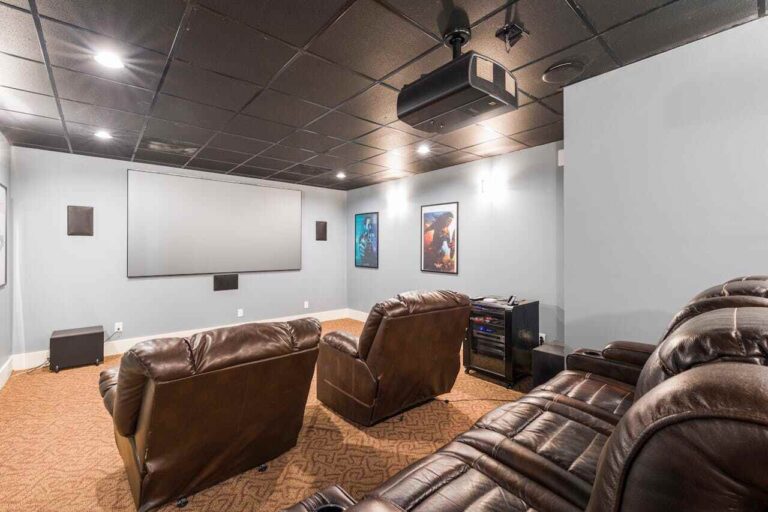Creating a home cinema is a dream come true for many entertainment enthusiasts. With advancements in technology and a wide range of affordable, high-quality products, bringing the cinematic experience into your home has never been easier. From designing the layout to selecting the best cinema seating, every detail matters when crafting your ultimate movie room.
This comprehensive guide will walk you through every step of building a home cinema, ensuring your setup is optimized for comfort, sound, and visual appeal. Dive in and start transforming your space into your personal movie haven.
Why Build a Home Cinema?
A home cinema isn’t just for watching blockbuster movies. It’s a multipurpose space that can elevate your experience of live sports, gaming nights, and binge-watching your favorite shows. No matter how you use it, the right setup will transform your entertainment, offering an immersive escape from the ordinary.
While the centerpiece of any home cinema is the screen and cinema seating, the details—from soundproofing to lighting—can make all the difference. Follow these steps to design a space that feels like a professional theatre.
What Do You Need for a Home Cinema?
To create a perfect home cinema, you need to focus on several key components:
- Room Selection and Layout
- Screen Type and Placement
- Seating Arrangement
- Audio Setup
- Lighting Design
- Soundproofing and Acoustics
- Control Systems and Accessories
Let’s break down each element.
1. Choosing the Right Room for Your Home Cinema
The first step is identifying the best room for your cinema. Decide whether it will be a dedicated theatre or a multipurpose space. Each choice has its pros and cons:
- Dedicated Room: Ideal for serious movie lovers; offers full control over sound, lighting, and layout.
- Multipurpose Room: Great for families but may require compromises, such as flexible cinema seating or dual-purpose furniture.
When choosing a room, consider its shape. Rectangular rooms are best for optimizing screen size, viewing angles, and sound distribution. If your room is square, you may need professional help to adapt the space for optimal acoustics and layout.
2. Selecting the Perfect Screen
The choice between a TV and a projector depends on your budget, room size, and desired experience:
- Televisions: Ideal for smaller, multi-use spaces. Modern TVs offer sharp visuals, bright screens, and vibrant colors, even in well-lit rooms.
- Projectors: Perfect for large rooms and dedicated cinemas. They provide expansive screen sizes and can be discreetly hidden when not in use.
Pro Tip: For the best viewing experience, your screen size should complement your room dimensions. Use the “viewing angle” rule: sit far enough that the screen’s angle spans 33°–62° of your vision.
3. Designing a Comfortable Seating Plan
Your choice of cinema seating significantly impacts comfort and viewing pleasure. Factors to consider include:
- Room Size: Optimize seating based on the screen’s size and viewing angles.
- Audience Needs: Tailor the seating style for your intended users. Families might prefer bean bags for flexibility, while couples might enjoy plush sofas for cozy viewing.
- Multi-Tiered Seating: For larger spaces, create tiers by elevating rows by 25–30 cm and spacing them at least 80 cm apart to ensure unobstructed views.
Whether you choose armchairs, recliners, or sofas, prioritize comfort and functionality.
4. Mastering Sound and Speaker Placement
Immersive sound is a hallmark of any great cinema. Invest in a surround sound system that creates an enveloping auditory experience. A 5.1 setup (five speakers and one subwoofer) is a popular choice:
- Front Speakers: Positioned on either side of the screen for balanced audio.
- Central Speaker: Dedicated to clear dialogue, placed under or behind the screen.
- Surround Speakers: Placed behind or above viewers for an immersive experience.
Proper placement ensures the sound complements the room’s layout without distortion.
5. Soundproofing and Acoustics
To prevent noise disturbances and enhance audio clarity, prioritize soundproofing:
- Wall Insulation: Add stud walls with sound-dampening materials.
- Acoustic Treatments: Use panels, carpets, and drapes to absorb echoes and block external noise.
- Window Coverings: Install heavy, lined curtains or blackout blinds.
- Doors and Floors: Replace hollow doors with solid ones and use acoustic underlays beneath thick carpets.
These measures ensure your audio system delivers crisp, clear sound.
6. Lighting for Ambiance
Lighting sets the mood and enhances the cinematic atmosphere. Start by eliminating ambient light with blackout curtains or motorized blinds. For added flair, consider:
- Recessed Lights: Installed along the ceiling or soffits.
- Dimmable Fixtures: Adjust brightness to create the perfect viewing environment.
- LED Strips: Add a modern touch with adjustable colors.
Keep lighting behind or above viewers to minimize glare.
7. Control Systems for a Seamless Experience
Centralized control systems simplify managing multiple features like lighting, audio, and ventilation. Integrating smart home technology allows you to adjust settings with voice commands or smartphone apps.
How Much Does It Cost to Build a Home Cinema?
The cost of building a home cinema varies based on your preferences:
- Budget-Friendly: A basic setup with a TV, soundbar, and simple seating starts at a few thousand dollars.
- Mid-Range: A projector, surround sound, and custom cinema seating might cost $10,000–$40,000.
- High-End: Fully customized cinemas with premium materials and advanced tech can exceed $100,000.
Final Touches
Personalize your home cinema with these extras:
- Vintage sconce lighting for a classic theatre vibe.
- Recliners or sofas with built-in cup holders and USB ports.
- A popcorn machine or mini-bar for snacks and drinks.
Conclusion
Building a home cinema is an exciting project that brings the magic of the big screen into your home. By focusing on layout, cinema seating, and technical details like sound and lighting, you can create a space that rivals commercial theatres. Start planning today and transform your entertainment space into a luxurious retreat.

